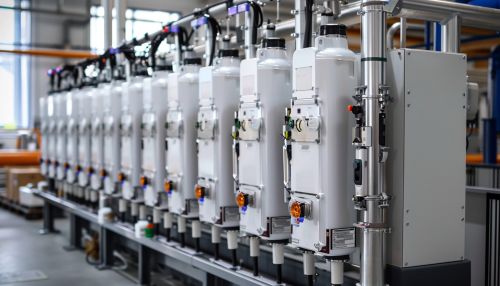Ultrafiltration
Introduction
Ultrafiltration is a membrane filtration process used to separate particles and solutes of high molecular weight from a liquid. This technique is widely applied in various industries, including water treatment, pharmaceuticals, food and beverage processing, and biotechnology. Ultrafiltration operates under the principle of size exclusion, where a semipermeable membrane allows the passage of water and low molecular weight solutes while retaining larger molecules and particles.
Principles of Ultrafiltration
Ultrafiltration membranes have pore sizes ranging from 1 to 100 nanometers, which makes them effective in removing bacteria, viruses, colloids, and macromolecules. The driving force for ultrafiltration is typically a pressure gradient, with pressures ranging from 1 to 10 bar. The process can be operated in either dead-end or cross-flow mode. In dead-end filtration, the feed flows perpendicular to the membrane surface, whereas in cross-flow filtration, the feed flows tangentially, reducing fouling and enhancing membrane lifespan.
Membrane Materials and Configurations
Ultrafiltration membranes can be made from various materials, including polymers such as polysulfone, polyethersulfone, and polyvinylidene fluoride, as well as inorganic materials like ceramics. These materials are selected based on their chemical resistance, mechanical strength, and compatibility with the feed solution.
Membrane configurations include flat sheet, tubular, hollow fiber, and spiral wound. Each configuration has its advantages and limitations. For instance, hollow fiber membranes offer a high surface area-to-volume ratio, making them suitable for large-scale applications, while flat sheet membranes are easier to clean and replace.
Applications of Ultrafiltration
- Water Treatment
Ultrafiltration is extensively used in water treatment to remove suspended solids, bacteria, and viruses. It serves as a pretreatment step for reverse osmosis systems and is also employed in the production of potable water from surface and groundwater sources.
- Pharmaceutical Industry
In the pharmaceutical industry, ultrafiltration is used for the concentration and purification of proteins, enzymes, and other biomolecules. It is also employed in the production of monoclonal antibodies and vaccines, where high purity and sterility are critical.
- Food and Beverage Industry
Ultrafiltration is applied in the food and beverage industry for the clarification of fruit juices, wine, and beer. It is also used in the dairy industry for the concentration of milk proteins and the removal of lactose to produce lactose-free products.
- Biotechnology
In biotechnology, ultrafiltration is used for cell harvesting, virus concentration, and the purification of nucleic acids. It is also employed in the production of biopharmaceuticals, where it plays a crucial role in downstream processing.
Advantages and Limitations
- Advantages
- High removal efficiency for particles and macromolecules. - Operates at relatively low pressures compared to other membrane processes. - Can be used for both concentration and purification. - Minimal chemical usage, making it environmentally friendly.
- Limitations
- Membrane fouling, which can reduce efficiency and increase operational costs. - Limited by the molecular weight cut-off of the membrane. - Requires periodic cleaning and maintenance to ensure optimal performance.
Membrane Fouling and Mitigation Strategies
Membrane fouling is a significant challenge in ultrafiltration, caused by the accumulation of particles, microorganisms, and macromolecules on the membrane surface. Fouling can lead to increased transmembrane pressure, reduced flux, and shorter membrane lifespan.
- Types of Fouling
- **Particulate Fouling:** Caused by the deposition of suspended solids. - **Organic Fouling:** Resulting from the adsorption of organic molecules. - **Biological Fouling:** Due to the growth of microorganisms on the membrane surface. - **Scaling:** Caused by the precipitation of inorganic salts.
- Mitigation Strategies
- **Pre-treatment:** Using coagulation, flocculation, or microfiltration to remove foulants before ultrafiltration. - **Chemical Cleaning:** Periodic cleaning with acids, alkalis, or detergents to remove fouling layers. - **Backwashing:** Reversing the flow direction to dislodge and remove accumulated particles. - **Cross-flow Operation:** Maintaining a tangential flow to reduce fouling and enhance membrane performance.
Future Trends and Developments
The field of ultrafiltration is continuously evolving, with ongoing research focused on developing more robust and efficient membranes, improving fouling resistance, and reducing operational costs. Advances in membrane materials, such as the development of nanocomposite and biomimetic membranes, hold promise for enhancing the performance and durability of ultrafiltration systems.
Additionally, the integration of ultrafiltration with other treatment processes, such as nanofiltration and reverse osmosis, is being explored to achieve higher levels of purification and resource recovery. The use of artificial intelligence and machine learning for process optimization and predictive maintenance is also an emerging trend in the industry.
See Also


